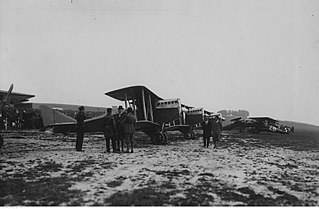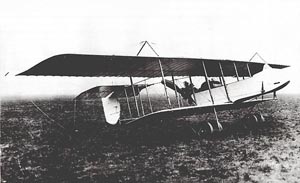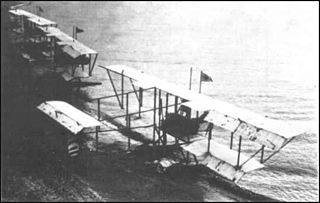Operators
 Belgium
Belgium - Aviation Militaire Belge/Belgische militaire luchtvaart - received four HF.16s in 1912 [1]
| HF.16 | |
|---|---|
| Role | Reconnaissance aircraft |
| Manufacturer | Farman |
| Designer | Henri Farman |
| First flight | 1912 |
The Farman HF.16 was a reconnaissance aircraft built in France shortly before the First World War.
Data from [2]
General characteristics
Performance

The Farman F.220 and its derivatives were thick-sectioned, high-winged, four engined French monoplanes from Farman Aviation Works. Based on the push-pull configuration proven by the F.211, design started in August 1925 and the first flight of the prototype was on 26 May 1932. The largest bomber to serve in France between the two world wars was the final F.222 variant. One variation was intended to be an airliner.

The Ansaldo A.300 was an Italian general-purpose biplane aircraft built by the Ansaldo company of Turin from 1920 to 1929. It also served as a light bomber, transport, fighter and reconnaissance aircraft, and finally as an advanced trainer, with examples in service as late as 1940. 50 examples were also license-built in Poland at ZM E. Plage & T. Laśkiewicz, but were not a success due to poor quality.

The Maurice Farman MF.7 Longhorn is a French biplane developed before World War I which was used for reconnaissance by both the French and British air services in the early stages of the war before being relegated to service as a trainer.

The Maurice Farman MF.11 Shorthorn is a French aircraft developed before World War I by the Farman Aviation Works. It was used as a reconnaissance and light bomber during the early part of World War I, later being relegated to training duties.

The Farman F.40 was a French pusher biplane reconnaissance aircraft.

The Farman HF.20 and its derivatives were a family of reconnaissance aircraft produced in France shortly before and during the First World War. It was a refined version of the Farman MF.11 "Shorthorn" that did away with the type's distinctive landing skids, and incorporated design features from Henri Farman's designs. It entered service with the French, Belgian and Serbian armies in 1913, and with the British RFC and RNAS shortly after the outbreak of war. The type was also licence-built in the UK by Airco and Grahame-White.

The Morane-Saulnier AR was a trainer aircraft produced in France during and after the First World War.

The Farman F.110 was a French two-seat artillery observation biplane designed and built by the Farman Aviation Works.
The Farman F.30A C2 was a two-seat biplane designed as a fighter in France in 1916 and powered by a single, water-cooled radial engine. It showed poor flight characteristics and only one was built, though it was modified twice. It should not be confused with the similarly named Henry Farman HF.30 of 1915, a completely different aircraft which was used in large numbers by the Imperial Russian Air Service.
The Stampe et Vertongen RSV.22 was a training biplane produced in Belgium in the 1920s.

The Farman HF.14 was a French two seat reconnaissance type produced by Farman Aviation Works before World War I.
The Henri Farman HF.35 was a large 3-seat biplane designed and built in France by Henri Farman during 1915.

The Farman HF.6 was a reconnaissance aircraft built in France shortly before the First World War.
The Farman HF.10 was a reconnaissance aircraft built in France shortly before the First World War.

The Farman HF.7 was a reconnaissance aircraft built in France shortly before the First World War.
The Maurice Farman MF.8 was a biplane floatplane, with a pusher engine, designed and built in France circa 1913.

The Maurice Farman MF.9 is a French bomber and reconnaissance biplane developed by Maurice Farman before World War I. Like the Maurice Farman MF.6, it used floats for take-off and landing on water.
The Maurice Farman MF.16 was a French reconnaissance aircraft developed before World War I by the Farman Aviation Works.
The Henry Farman HF.19 was a French reconnaissance seaplane developed by Henry Farman before World War I. As a floatplane, it used floats for take-off and landing on water.

The Morane-Borel military monoplane was an unsuccessful French single-engine, multi-seat prototype aircraft built in 1911 for the Reims Military Aviation Competition hosted by the French Army. The aircraft only met one of the requirements and was eliminated from the competition.